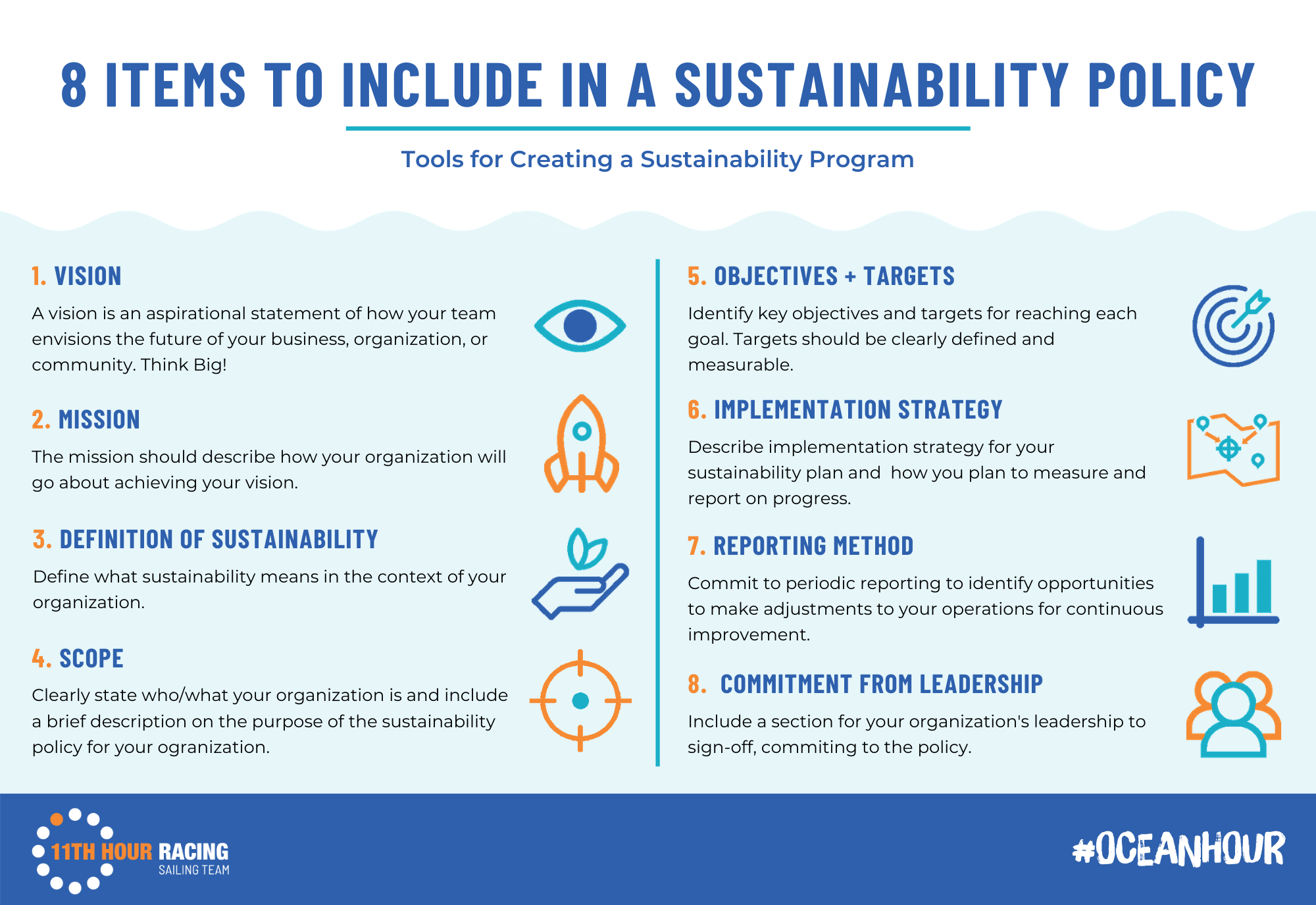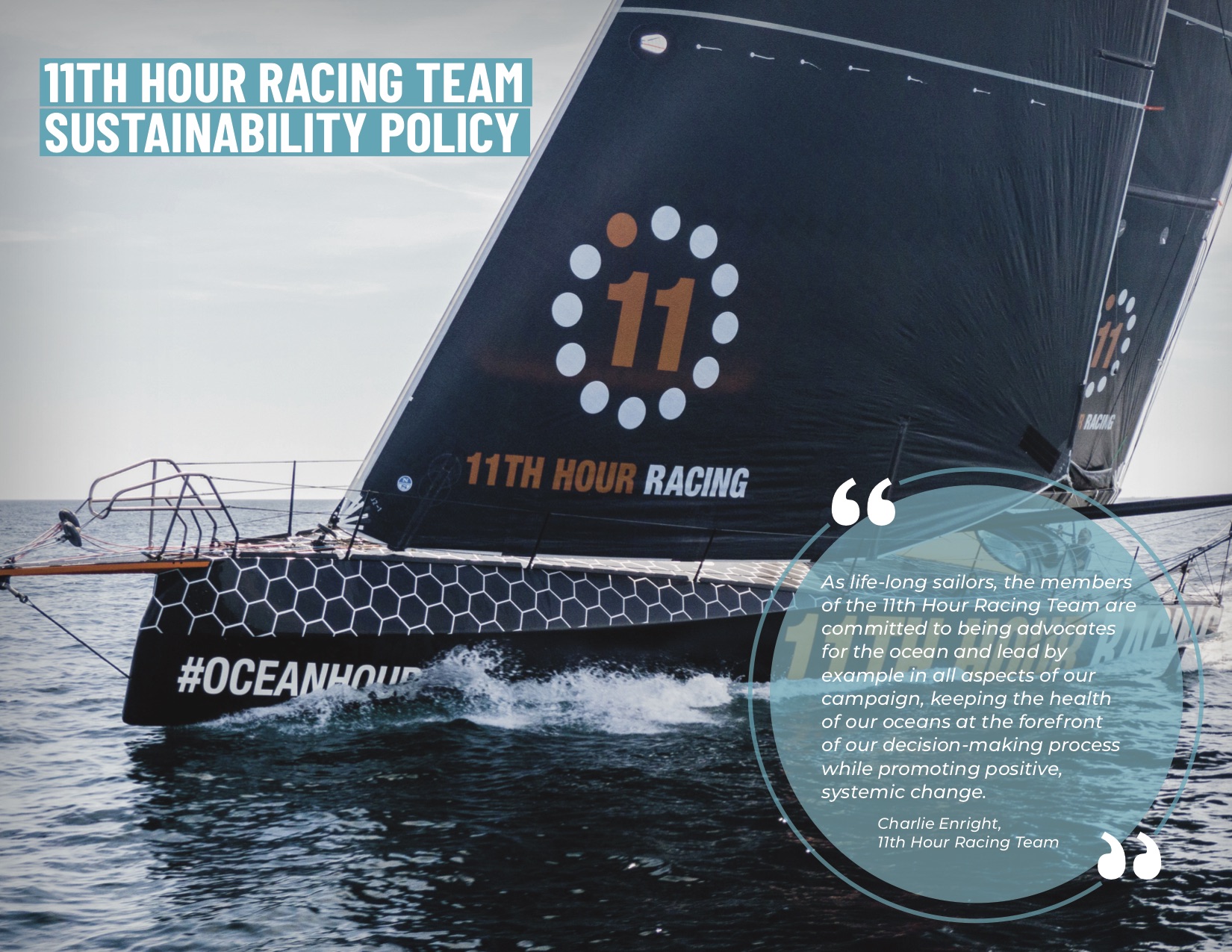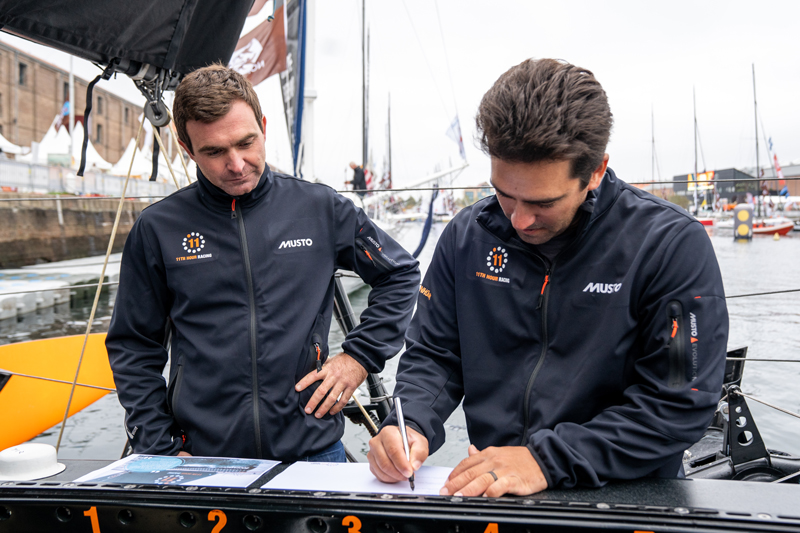How to Create a Sustainability Policy
Sports teams, leagues and events around the world are recognizing the importance and positive benefits of moving to more sustainable and environmentally-friendly operations. Ready to join the club? We’ve got you covered!
Once it’s decided to embed sustainability into the ethos and operations of your organization, it can be daunting to know where to begin. We asked 11th Hour Racing Team’s Sustainability Officer, Amy Munro, to break down the basics of how our team created our 11th Hour Racing Team Sustainability Policy.
The policy is a starting point that acts as a roadmap for establishing a comprehensive sustainability program for your team, event or sailing organization.

8 Items to include in your sustainability policy:
1. Vision: A vision is an aspirational statement of how your team envisions the future of your business, organization, or community. Think big! Here are some inspiring examples, along with our team’s vision statement:
- Vibrant, healthy oceans and communities supported and inspired by the sport of sailing.
2. Mission: The mission should describe how your organization will go about achieving your vision.
- Example: 11th Hour Racing Team’s mission is to win The Ocean Race 2021- 22 with sustainability at the core of all team operations, inspiring positive action among sailing and coastal communities, and global sports fans to create long-lasting change for ocean health. We will accelerate change through sporting excellence in sailing, ocean advocacy, and sustainable innovation.
3. Definition of Sustainability: Sustainability is a broad term, covering a wide range of topics. You’ll want to define what sustainability means in the context of your organization.
- Example: 11th Hour Racing Team defines sustainability as the intrinsic balance between the social, economic and environmental aspects of our everyday actions, which respects the world’s oceans, natural resources and the needs of current and future generations. We believe that sustainability requires intergenerational empathy: our collective actions today will ensure healthy communities, prosperous economies and a thriving planet for future generations.
4. Scope: Include a brief description of the purpose of the sustainability policy. Clearly state what activities your sustainability program applies to within your organization and state this in your policy. Does it apply to just one part of your operations or all of the activities of your organization?
- Example: The 11th Hour Racing Team is an offshore sailing team competing in the 2021-2022 edition of the The Ocean Race. This policy is relevant to all our activities relating to the preparation and participation in the 14th edition of the race. Here we describe our team’s vision and mission, our definition of sustainability and core values, how the sustainability strategy identifies areas of focus for the team, and outline our commitment to transparent reporting and continual improvement. The sustainability plan will detail our goals, objectives and strategies for implementation.
5. Organization Objectives & Targets: Your organization should identify key objectives and targets for reaching each objective. It’s important that targets are clearly defined, and allow you to measure and quantify your progress.
To help organize goals and targets, our team identified four guiding principles around our team operations and campaign objectives: Innovation, Leadership, Legacy, and Collaboration. Not only will these principles help establish our goals and objectives, but they provide a platform to communicate our sustainability initiatives.
Our policy defines these principles with high level goals, while the sustainability plan will expand on each of these areas in more detail with associated targets.
6. Strategy for Implementation + Monitoring: This section of your policy allows you to describe your implementation strategy for your larger program. You’ll want to make sure you can continuously measure and report on your objectives to make sure you are on track to meet your targets.
- Example: If you have a target to offset your team’s carbon footprint from travel by 100%, you’ll need to have a system in place to track your footprint, make all available efforts to minimize it, and create a plan to offset the remaining footprint.
7. Reporting: Your organization should commit to periodic reporting to allow you to make adjustments to your operations for continuous improvement. This is a good opportunity to align your organization with any governing bodies or sustainability standards.
- Example: 11th Hour Racing Team’s sustainability plan will conform with ISO 20121 Sustainable Event Management Systems, and aligns with industry and sport-relevant sustainability standards to ensure credibility and transparency through robust monitoring and reporting. These include the Global Reporting Initiative, the UN Sustainable Development Goals, and the World Sailing Sustainability Agenda 2030.
8. Commitment from Leadership: Include a section for your organization’s leaders to sign-off, committing to the policy and demonstrating a culture of support and accountability from the top down.

Four Tips for Drafting your Sustainability Policy:
1. Establish a Starting Point
IOC Sustainability Essentials guidelines emphasizes that “it’s important to assess your starting point.” Make a list of what your organization is currently doing for sustainability. Look at opportunities to implement change, and identify roadblocks for implementation.
2. Align with Industry and Global Standards
It is important to align with global and industry goals to give a clear focus to your plan. This encourages benchmarking and comparability to showcase where there are common areas of interest with suppliers and stakeholders.
11th Hour Racing Team developed a framework with measurable objectives and targets that align with ISO 20121, UN Sustainable Development Goals (UNSDGs) and The World Sailing Sustainability Agenda 2030.
3. Engage Stakeholders
It’s very important to develop your policy and plan to reflect the interests and needs of groups that your activities impact.
The advantage of engaging stakeholders while writing your policy and plans often means that you can better identify challenges and collaborate on solutions and opportunities. This will allow you to maximize the impact of your program while creating stronger relationships with aligned values.
We suggest mapping out all different types of stakeholders for your organization. Make a plan for how to best engage with each group – surveys, group calls, newsletters etc. Take them on the journey with you, providing multiple opportunities for feedback and align on how often you will communicate progress of your plans as they develop.
Examples of key stakeholders could include: staff members, staff families, your supply chain, customers, sponsors, governing and industry bodies, local councils, partners, investors, local and online communities, etc.
4. Gather Feedback
After creating your policy, you’ll want to communicate the final policy with all interested parties. Take your stakeholders on the journey with you. Providing multiple opportunities for feedback and align on how often you will communicate progress of your plans as they develop.
Next Steps
Once you have written your sustainability policy, which will outline the overall framework of your strategy, you can then engage further with stakeholders to build out your objectives and a comprehensive set of targets for your sustainability plan.
The sustainability plan is a detailed playbook of how you go about completing your mission and describes how your organization will:
- Assign resources to achieving your targets
- Define roles and responsibilities
- Assess progress against your goals
- Report and communicate
- Continuously improve against your targets
The International Olympic Committee has put together a series of useful guides that establish a framework for building out your program. To follow the process download the guide here.
Our goal is to be as transparent as possible to help other future-friendly teams establish successful sustainability programs. As our team continues to build out our #oceanhour (sustainability) program with the support of our sponsor 11th Hour Racing and their Sustainability Director Jill Savery, we’ll continue to share our successes, challenges, and key learnings throughout our campaign.
Sources:
- Jill Savery, Sustainability Director, 11th Hour Racing
- Sustainability Essentials, International Olympic Committee
- ISO 20121.2012, Sustainable Event Management System Requirements
- University of Cambridge Institute for Sustainability Leadership (CISL) (2017). Rewiring Leadership, The future we want, the leadership we need. Cambridge, UK
- University of Cambridge Institute for Sustainability Leadership (CISL) (2017). Towards a sustainable economy: The commercial imperative for business to deliver the UN Sustainable Development Goals. Cambridge, UK
- Scott, M., (2017) Engaging with the UN’s Sustainable Development Goals. The Telegraph.




